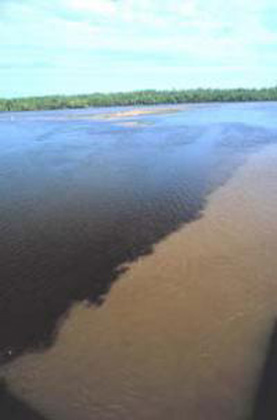For fishing fleets in the Gulf of Mexico, one of the biggest threats to success is the annual “dead zone” -- a region off the coast of Louisiana where fish and shellfish all but disappear.
Yet the dead zone isn’t really dead. In fact, it teems with life. Unfortunately for the fishing fleets, though, it’s of the microscopic variety. It kills or chases away the bigger life by using up all the oxygen.
 The Missisippi River dead zone is overloaded with nutrients from upstream sources. This photo shows the color change between the hypoxic (brown) and oxygen-rich (blue) waters. Credit: National Oceanic and Atmospheric Administration
The Missisippi River dead zone is overloaded with nutrients from upstream sources. This photo shows the color change between the hypoxic (brown) and oxygen-rich (blue) waters. Credit: National Oceanic and Atmospheric AdministrationThe dead zone forms in summer, when the Mississippi River dumps waters filled with nutrient-rich runoff from farms across the American heartland into the Gulf of Mexico. Combined with the summer sunshine, the nutrients create a massive bloom of tiny plants at the surface of the Gulf -- the first wave of “dead-zone” life.
These organisms provide food for fish. But what doesn’t get eaten eventually dies and falls to the ocean floor. There, the remains are consumed by other types of microscopic life. A massive dose of dead algae creates massive numbers of these organisms -- tens of millions of them for every cubic inch of sediments -- the second wave of “dead-zone” life.
But these tiny creatures consume oxygen. Within weeks, they use most or all of the oxygen in the bottom layers. That forces out or kills fish, crabs, shrimp, and other large critters.
In 2011, the dead zone covered about 6800 square miles -- a bit less than expected. Yet this large patch of Gulf waters wasn’t really dead -- it was just filled with tiny organisms that deprive our plates of the bigger and tastier kind.

